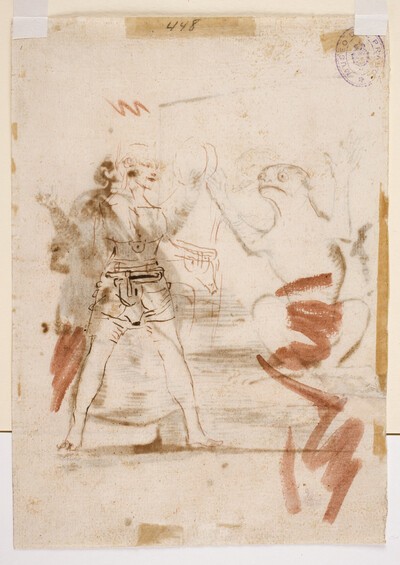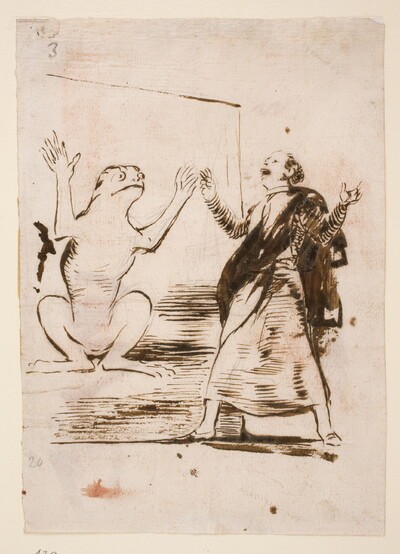- Cronología
- Ca. 1797
- Ubicación
- The Prado National Museum. Madrid, Madrid, Spain
- Dimensiones
- 200 x 141 mm
- Técnica y soporte
- Reconocimiento de la autoría de Goya
- Documented work
- Titular
- El Prado National Museum
- Ficha: realización/revisión
- 20 Aug 2021 / 20 Apr 2023
- Inventario
- D3957
16 (in pencil, recto, lower left)
110 (in composite pencil, recto, upper part)
MUSEO DEL PRADO (Stamp in violet ink, reverse, upper left)
Watermark: [Shield with helmet, bird inside, and below "D.N J.PH GISBERT / ALCOY"] (top half)
The drawing passed by inheritance in 1828 to Javier Goya, the painter's son, and in 1854 to Mariano Goya y Goicoechea, the artist's grandson. It was subsequently owned by Valentín Carderera (ca. 1861) and Mariano Carderera (ca. 1880). In 1886 it was acquired from Mariano Carderera by the General Direction of Public Instruction and was assigned to the Prado Museum, where it entered on 12 November 1886.
This drawing, although it departs from the technical characteristics of the Magic Mirror series of drawings, has many thematic and iconographic similarities with two of the works in the same series: Student/Frog and Figure with Chastity Belts, sketches of two figures and a frog, in which the protagonists are giant frogs.
Gassier states that it may be an unrealised Caprice project but that it arose from the same physiognomonistic current as the symbolic representations of the four temperaments (melancholic, sanguine, choleric and phlegmatic) which the Magic Mirror (Woman/Snake) series seems to be.
-
Goya. Gemälde Zeichnungen. Graphik. TapisserienKunsthalle BaselBasle1953from January 23th to April 12th 1953
-
Los dibujos de GoyaMuseo Provincial de ZaragozaZaragoza1978exhibition organized by Museo Provincial de Zaragoza, Ministerio de Cultura and Ayuntamiento de Zaragoza, exhibition guide written by Miguel Beltrán Lloris and Micaela Pérez Sáenz. October 1978
-
Goya. Das Zeitalter der Revolucionen. Kunst um 1800 (1980 – 1981)Hamburger KunsthalleHamburg1980
-
Europa 1789. Aufklärung, Verklärung, VerfallHamburger KunsthalleHamburg1989
-
Barcelona2004
-
MadridMuseo del Prado1954n. 209
-
Goya, Saturno y melancolía. Consideraciones sobre el arte de GoyaStockholmAlquimis & Wiksell1962pp. 94-115
-
Vie et ouvre de Francisco de GoyaParísOffice du livre1970p. 187, cat. 655
-
Dibujos de Goya, 2 volsBarcelonaNoguer1975p. 498, cat. 327
-
Goya, Das Zeitalter de Revolutionen. 1789-1830HamburgPrestel-Verlag Münche und Hamburger Kunsthalle1980p. 230, il. 127
-
ZaragozaCaja de Ahorros de Zaragoza, Aragón y Rioja1980-1982p. 130
-
Universidad de Salamanca2008



